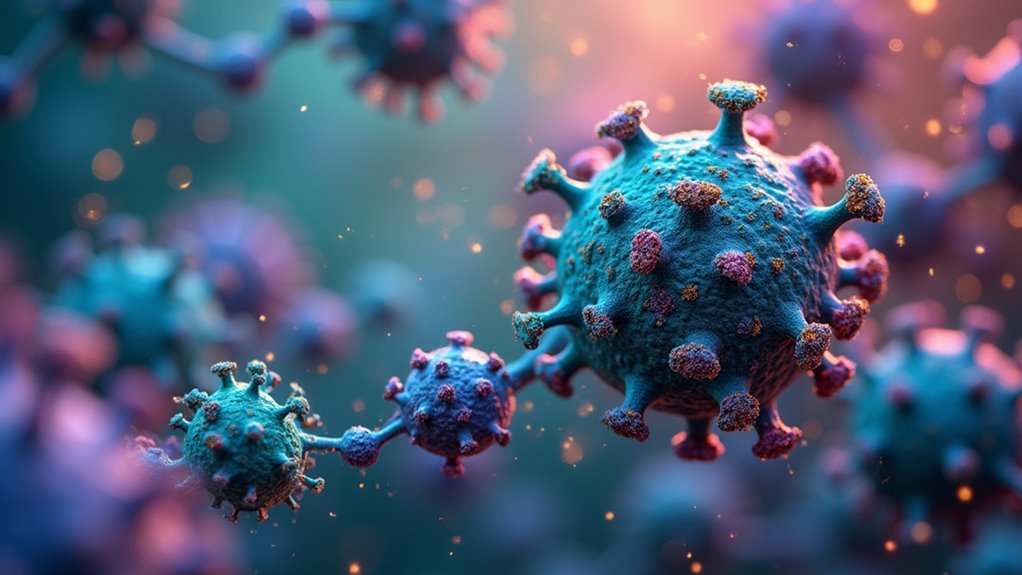Vaccines use the chemistry of the immune system to teach your body to recognize pathogens. They introduce antigens—protein, sugar, or genetic material—that are processed by immune cells, prompting the production of antibodies and memory cells. Technologies like mRNA or protein subunit vaccines mimic infection without causing illness. Adjuvants boost responses, while newer methods enhance safety and effectiveness. If you explore further, you’ll discover how these diverse components work together to create lasting immunity.
Key Takeaways
- Vaccines introduce antigens that are recognized by immune cells, initiating a cascade of immune responses.
- Antigen-presenting cells process vaccine components and display fragments on MHC II molecules to activate T helper cells.
- Activated T cells stimulate B cells to produce specific antibodies, creating a targeted immune defense.
- Vaccine-induced memory B and T cells enable rapid, long-lasting protection upon future pathogen exposure.
- Modern vaccines use molecular techniques like mRNA and recombinant proteins to precisely mimic pathogen antigens and stimulate immunity.
How Vaccines Stimulate the Immune System
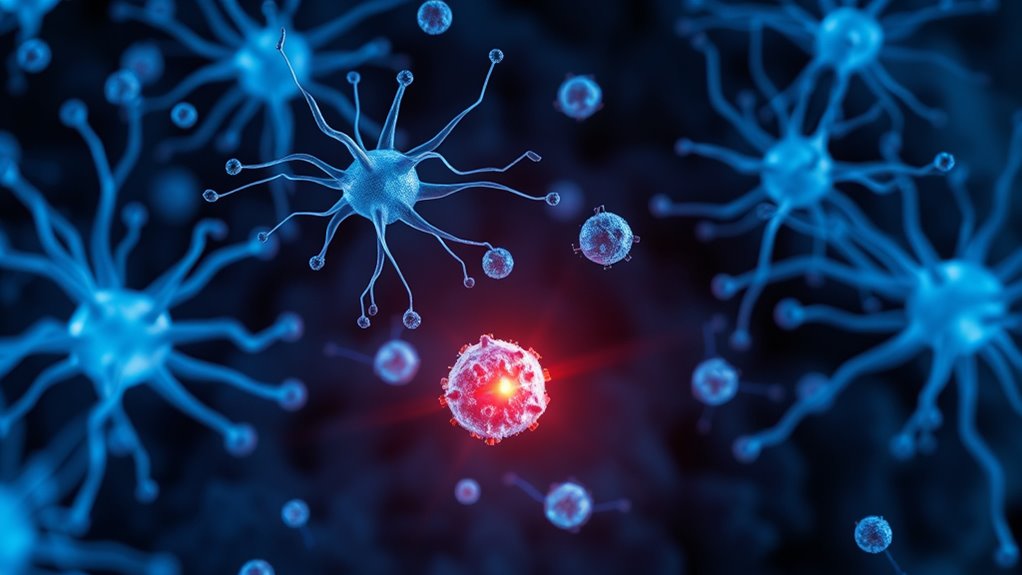
Vaccines stimulate your immune system by introducing weakened or inactivated pathogens, or their fragments, that mimic infections without causing illness. The antigen’s structure—proteins, polysaccharides, or genetic material—determines how your immune system recognizes it. A proper dose triggers defenses without overwhelming your body.
Adjuvants like alum boost this process by activating innate immune pathways, such as inflammasomes. When administered, usually via intramuscular injection, vaccines target antigen-presenting cells in muscle or lymphoid tissue. These cells detect pathogen-associated molecular patterns (PAMPs) in the vaccine, activating receptors like TLRs on dendritic cells. The activation of these receptors is essential for initiating a strong immune response. This activation releases cytokines, recruiting immune cells like neutrophils and macrophages, which set the stage for a robust adaptive response. This rapid innate activation primes your body for long-term immunity.
Furthermore, the immune recognition process involves complex molecular interactions that ensure the immune system can distinguish between harmful pathogens and harmless substances.
Types of Vaccines and Their Components
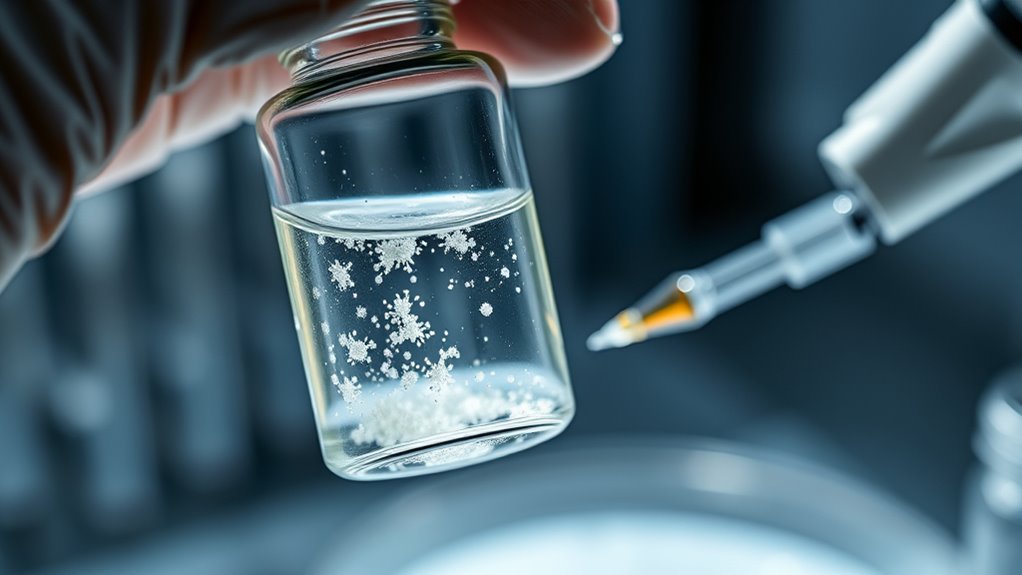
There are several types of vaccines, each designed to safely stimulate your immune system in different ways. Live-attenuated vaccines use weakened germs to trigger strong immunity without causing illness.
Inactivated vaccines contain killed pathogens, which require multiple doses for lasting protection.
mRNA vaccines deliver genetic instructions for your cells to produce a pathogen protein, prompting immunity without using the live virus.
Subunit, recombinant, polysaccharide, and conjugate vaccines focus on specific pieces of the microbe, such as proteins or sugars, reducing side effects. These targeted components help minimize immune reactions to non-essential parts of the pathogen.
Viral vector vaccines employ harmless viruses to deliver pathogen genes, stimulating an immune response without the actual pathogen.
These vaccines include active components like antigens and may contain adjuvants, stabilizers, preservatives, or trace components to enhance effectiveness and stability. Vaccine ingredients such as adjuvants and stabilizers are carefully evaluated for safety and purpose.
The Role of Antigens in Vaccination
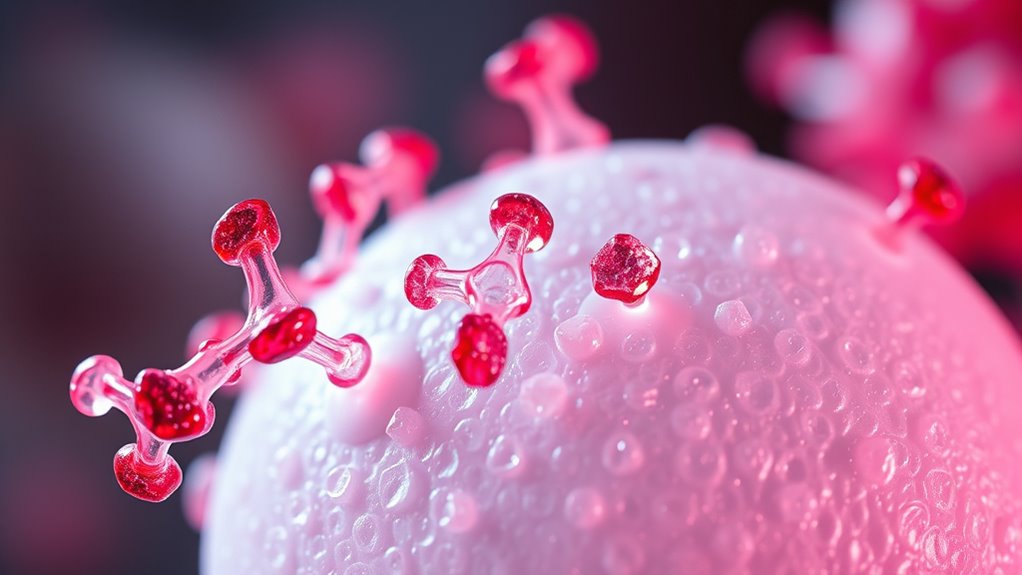
Antigens are the key components that enable vaccines to stimulate your immune system effectively. They’re substances that trigger your body to produce antibodies, helping your immune system recognize and fight real pathogens in the future.
Vaccines contain antigens that mimic parts of viruses or bacteria, providing a safe way to prepare your immune defenses. When introduced, these antigens are recognized by antigen-presenting cells (APCs), which display fragments to T-cells, activating your immune response.
Different types of antigens include proteins, polysaccharides, or genetic material like DNA and RNA. Once recognized, T-cells help B-cells produce targeted antibodies, creating a long-lasting immune memory.
This process ensures your body is ready to fight the actual pathogen if you’re exposed later.
How Mrna Vaccines Work at the Molecular Level

mRNA vaccines work by delivering genetic instructions directly into your body’s cells, prompting them to produce specific viral proteins. This is achieved through synthetically created mRNA that mimics natural eukaryotic mRNA, including a 5′ cap, UTRs, an open reading frame, and a poly(A) tail. Modifications like synthetic 5′-cap analogues enhance stability and translation efficiency. Once inside your cells, the mRNA penetrates the lipid bilayer and reaches the cytoplasm, where ribosomes translate it into viral proteins, such as the spike protein. These proteins mimic parts of the virus, triggering your immune system to respond. Because mRNA is short-lived and degrades quickly, antigen production is transient, minimizing long-term effects while effectively activating both innate and adaptive immunity. Encapsulation in lipid nanoparticles protects the mRNA from degradation and facilitates its entry into cells, ensuring efficient delivery and expression.
Protein Subunit Vaccines: Building Immunity With Protein Pieces
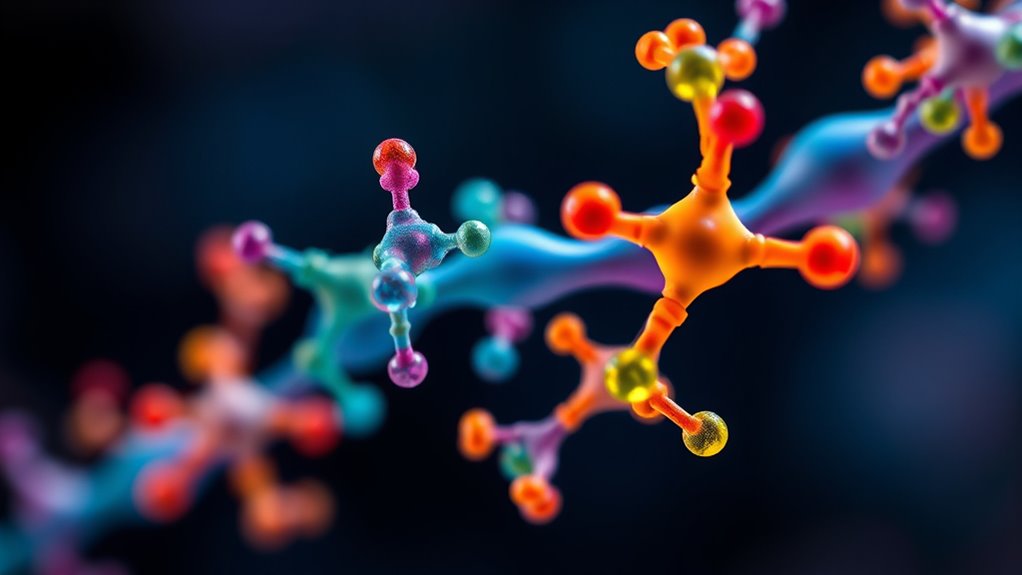
Building on how mRNA vaccines instruct your cells to produce viral proteins, protein subunit vaccines rely directly on delivering purified pieces of the pathogen itself. These vaccines contain specific protein fragments, such as viral or bacterial antigens, produced using recombinant DNA technology in insect, yeast, or bacterial cells. They stimulate your immune system by presenting these targeted antigens, prompting antibody production and cellular responses without exposing you to the whole microbe. Often combined with adjuvants, they enhance immune activation. Because they contain only purified protein pieces, they’re very safe—they can’t cause disease. This focused approach helps your body recognize and respond to critical pathogen components, providing effective immunity while minimizing side effects. Manufactured using recombinant DNA technology Protein subunit vaccines are used for diseases like hepatitis B, HPV, and COVID-19. Additionally, their safety profile makes them suitable for a wide range of populations, including those with compromised immune systems.
Conjugate Vaccines and the Power of Carrier Proteins

Have you ever wondered how some vaccines generate a stronger and longer-lasting immune response than others? Conjugate vaccines do this by linking a weak polysaccharide antigen to a carrier protein, boosting immunogenicity. The covalent bond makes the polysaccharide more recognizable to your immune system, activating B cells and engaging T cells for a robust response. Common carriers include diphtheria toxoid, tetanus toxoid, and CRM197. These conjugates help produce high-quality antibodies and memory cells, ensuring long-term protection. Different carrier proteins can influence antibody levels and strength, and some can conjugate with multiple polysaccharides for broader coverage. Effective vaccine design leverages these conjugate strategies to improve immune responses across diverse populations.
The Function of Adjuvants in Enhancing Immune Responses

Conjugate vaccines strengthen immune responses by linking polysaccharide antigens to carrier proteins, making them more recognizable to the immune system.
Adjuvants play a pivotal role by boosting these responses further. They enhance vaccine efficacy by increasing inflammation and improving antigen presentation, stimulating immune cells like dendritic cells, and inducing cytokines that orchestrate immune activity.
Different adjuvants, such as aluminium salts, MPLA, and CpG, have unique properties that help activate immune pathways and modulate the microenvironment for better activation.
Adjuvants also allow for lower antigen doses, reducing side effects and costs, and can shorten vaccination schedules by strengthening responses.
Ongoing research explores new compounds, nanotechnology, and molecular methods to improve safety, effectiveness, and long-term immunity. Understanding vaccine mechanisms is essential for developing more efficient immunization strategies.
The Process of Immune Activation and Memory Formation

When a vaccine introduces antigens that mimic infection, your immune system quickly springs into action to recognize and respond to these foreign molecules. Antigen-presenting cells, like macrophages and dendritic cells, ingest and process the vaccine components, then display fragments on MHC II molecules.
This activates naive CD4+ T helper cells, which proliferate and differentiate into subsets that coordinate immune responses. Activated T cells stimulate B cells, prompting them to clone and produce antibodies that neutralize pathogens or mark them for destruction.
Some B cells become memory cells, ready for rapid response. Memory T and B cells persist long-term, enabling your immune system to respond faster and more effectively if re-exposed.
This process guarantees durable protection and forms the foundation of vaccine-induced immunity.
Advances in Vaccine Technology and Future Prospects

Recent advances in vaccine technology are revolutionizing how you develop and deploy immunizations. Genetic engineering enables precise manipulation of viral genomes, making vaccines safer and adaptable to new strains. Viral vector technology uses harmless viruses to deliver genetic material, prompting your immune system to produce targeted antigens. Cloning techniques allow rapid customization of vaccines, speeding up responses to emerging threats. Nanotechnology improves delivery by using nanoparticles that target immune cells directly, boosting efficacy and reducing side effects. mRNA and viral vector platforms, like those used for COVID-19, demonstrate how speed and flexibility can save lives. T-cell focused vaccines are also emerging, aiming for broader, longer-lasting protection. The table below highlights key advancements:
| Technology | Benefit | Future Potential |
|---|---|---|
| Genetic Engineering | Safer, adaptable vaccines | Rapid response to new strains |
| Nanotechnology | Precise delivery, efficacy | Broader disease coverage |
| mRNA & Viral Vectors | Fast development, high efficacy | Versatile for various diseases |
This progress in vaccine technology relies on innovative delivery methods that enhance immune response and safety.
Frequently Asked Questions
How Do Vaccines Provide Lifelong Immunity?
You might wonder how vaccines give you lifelong immunity. When you get vaccinated, your immune system forms memory B and T cells, which quickly respond if you’re exposed again.
Vaccines targeting stable viruses help create long-lasting protection because their structures don’t change much. Live-attenuated vaccines stimulate strong immune responses, leading to durable immunity.
Over time, boosters can help maintain this protection, especially for viruses that mutate rapidly.
What Are Potential Side Effects of Different Vaccine Types?
You might experience side effects from various vaccine types. mRNA vaccines can cause soreness, fatigue, headache, muscle pain, chills, fever, nausea, and vomiting.
Protein subunit vaccines often lead to soreness, fatigue, headache, muscle and joint pain, chills, fever, nausea, and vomiting.
Traditional inactivated or live-attenuated vaccines may cause soreness, fever, fussiness, tiredness, loss of appetite, vomiting, and, rarely, seizures or serious reactions.
Meningococcal vaccines can result in soreness, fatigue, headache, fever, chills, nausea, diarrhea, fainting, or rare allergic reactions.
How Do Vaccines Prevent the Spread of Diseases in Populations?
Imagine a community where most people are vaccinated against measles. You’re protected because the virus struggles to spread when few susceptible individuals remain.
Vaccines prevent disease spread by creating herd immunity, reducing the number of hosts the pathogen can infect. This limits outbreaks and protects vulnerable groups.
Why Do Some Vaccines Require Booster Shots?
You might wonder why some vaccines need booster shots. It’s because your immune response can weaken over time, especially if the vaccine’s protection isn’t long-lasting. Boosters help reinforce your immune memory, ensuring you stay protected.
They also help address virus mutations or variants. By getting boosters, you maintain high immunity levels, reduce disease spread, and protect vulnerable populations, keeping both you and your community safer.
How Do New Vaccine Technologies Address Emerging Pathogens?
You see, new vaccine technologies swiftly, securely, and specifically step up to shield against swiftly spreading pathogens. mRNA vaccines deliver detailed genetic directives, prompting your cells to produce targeted antigens, while viral vectors mimic mutants without risks.
Nanoparticles and recombinant proteins craft customizable, concentrated antigens. These advanced approaches adapt rapidly, address antigenic shifts, and arm you against emerging threats, ensuring effective, efficient, and evolving defenses in the face of future infectious invaders.
Conclusion
Now that you understand how vaccines work at the molecular level, it’s incredible to realize they save over 3 million lives worldwide each year. By stimulating your immune system with carefully designed components, vaccines provide lasting protection against dangerous diseases. As technology advances, future vaccines will become even safer and more effective. Your participation in vaccination programs not only protects you but also helps build a healthier, disease-free world for everyone.
